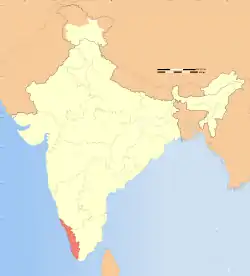Kerala Day
Kerala Day also referred to as Kerala Piravi, marks the birth of the state of Kerala in southern India. The state of Kerala was created on 1 November 1956, long after the Independence of India. Before this, it was three major provinces and several outlying regions under various rulers.

Timeline/History
Prior to 1956, Kerala had been divided into three regions: Malabar, Cochin and Travancore.
Malabar comprises the northern and north-central region around Cannanore, Calicut, and Palghat, with some portions of Kochi. This region had been ruled by the Zamorin of Calicut, Arakkal kingdom, and Kingdom of Valluvanad, with several other smaller feudal states, before being unified by Tipu Sultan. It was then ceded to the British East India Company after the Anglo-Mysore Wars, [1][2] and annexed to the British Madras Presidency. [3][4][5] The coastal town of Mahe remained a French enclave until the early 1950s when it was integrated into the Union Territory of Puducherry. The central region comprised the erstwhile Kingdom of Cochin, administered from Thrissur. The southernmost province was the Kingdom of Travancore, based in the city of Thiruvananthapuram. While Cochin had been a vassal state under the British Raj, Travancore Kingdom was administered under suzerainty.
Early in the 20th century, the Mappila Muslims of the Calicut region revolted against the Hindu zamindars and the British Raj.[6] In the following years, agitations for political rights and a popular government took place in Travancore and Cochin as well. After India was partitioned in 1947 into India and Pakistan, Travancore and Cochin, part of India were merged on 1 July 1949 to form Travancore-Cochin.[7] A popular movement known as Aikya Kerala (United Kerala), for the formation of the State of Kerala, gave an impetus to the reorganisation of the state on a linguistic basis.[8][9]
On 1 November 1956, the taluk of Kasargod in the South Kanara district of Madras, the Malabar district of Madras, and Travancore-Cochin, without four southern taluks (which joined Tamil Nadu), merged to form the state of Kerala under the States Reorganisation Act.[10][11] A Communist-led government under E. M. S. Namboodiripad came to power following the first elections for the new Kerala Legislative Assembly in 1957.[11] It was one of the earliest elected Communist governments, after Communist success in the 1945 elections in the Republic of San Marino.[12][13][14]
References
- British Museum; Anna Libera Dallapiccola (22 June 2010). South Indian Paintings: A Catalogue of the British Museum Collection. Mapin Publishing Pvt Ltd. pp. 12–. ISBN 978-0-7141-2424-7. Retrieved 18 November 2012.
- Edgar Thorpe, Showick Thorpe; Thorpe Edgar. The Pearson CSAT Manual 2011. Pearson Education India. p. 99. ISBN 978-81-317-5830-4. Retrieved 18 November 2012.
- The Edinburgh Gazetteer. Longman, Rees, Orme, Brown, and Green. 1827. pp. 63–. Retrieved 18 November 2012.
- Dharma Kumar (1965). Land and Caste in South India: Agricultural Labor in the Madras Presidency During the Nineteenth Century. CUP Archive. pp. 87–. GGKEY:T72DPF9AZDK. Retrieved 18 November 2012.
- K.P. Ittaman (1 June 2003). History of Mughal Architecture Volume Ii. Abhinav Publications. pp. 30–. ISBN 978-81-7017-034-1. Retrieved 18 November 2012.
- M. Naeem Qureshi (1999). Pan-Islam in British Indian Politics: A Study of the Khilafat Movement, 1918–1924. BRILL. pp. 445–447. ISBN 978-90-04-11371-8.
- Gopa Sabharwal (2007). India Since 1947: The Independent Years. Penguin Books India. pp. 23–. ISBN 978-0-14-310274-8. Retrieved 18 November 2012.
- http://www.manoramaonline.com/cgi-bin/mmonline.dll/portal/ep/gulfContentView.do?contentId=732939&programId=1073751464&channelId=-1073750346&BV_ID=@@@
- "Archived copy". Archived from the original on 28 June 2013. Retrieved 9 April 2013.CS1 maint: archived copy as title (link)
- Nossiter, Thomas Johnson (1982). Communism in Kerala: A Study in Political Adaptation. University of California Press. p. 12. ISBN 9780520046672.
- Sarina Singh; Amy Karafin; Anirban Mahapatra (1 September 2009). South India. Lonely Planet. ISBN 978-1-74179-155-6. Retrieved 6 January 2013.
- K.G. Kumar (12 April 2007). "50 years of development". The Hindu. Retrieved 30 August 2013.
- Manali Desai (27 November 2006). State Formation and Radical Democracy in India. Taylor & Francis. p. 142. ISBN 978-0-203-96774-4. Retrieved 31 August 2013.
- Madan Gopal Chitkara; Baṃśī Rāma Śarmā (1 January 1997). Indian Republic: Issues and Perspective. APH Publishing. pp. 134–. ISBN 978-81-7024-836-1. Retrieved 18 November 2012.